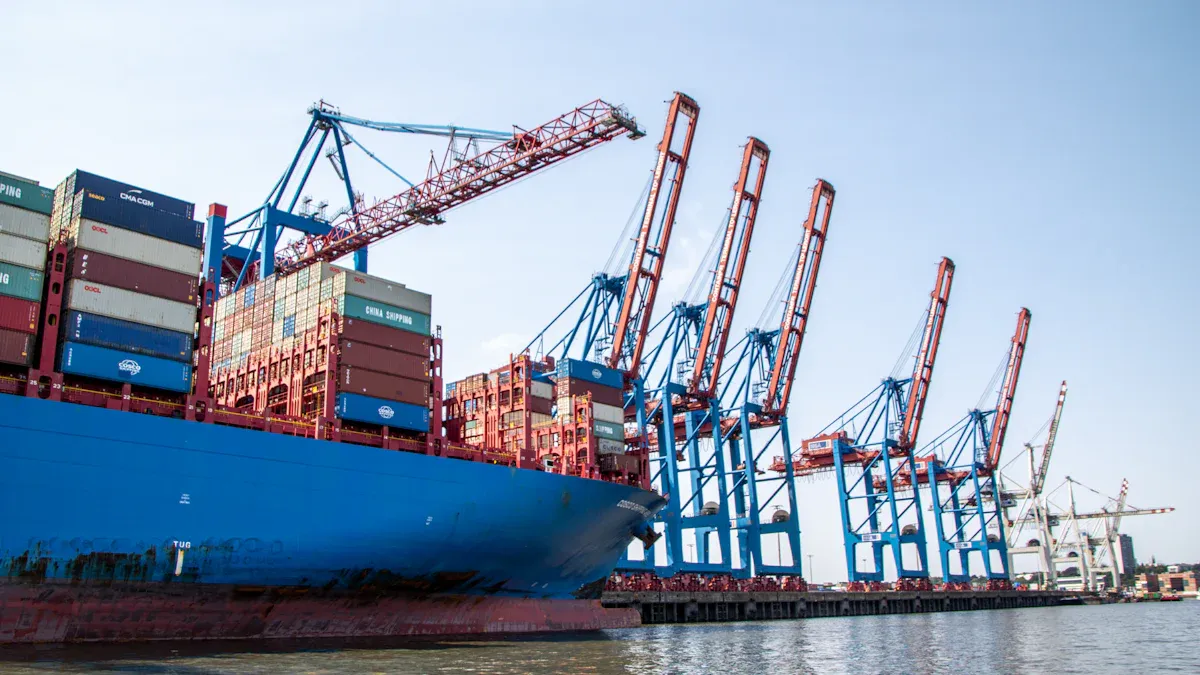Flexible solutions for China-Europe land transportation under geopolitical circumstances

Moving goods between China and Europe has always been a logistical challenge, but shifting geopolitical dynamics have made the process even trickier. Trade imbalances and growing demand for faster, more adaptable shipping options underscore the need for flexible logistics solutions. For instance, the EU imported over $190 billion more from China than it exported in 2016, creating a heavy reliance on westbound shipments. Meanwhile, cargo volumes on major rail routes jumped from 21,900 FEUs in 2016 to 37,000 FEUs in 2017. These trends highlight the importance of alternatives like road freight, which offers quicker transit times and sanctions-compliant routes. JUSDA’s tailored services ensure businesses can navigate these complexities with ease.
Key Takeaways
Trucks are fast and flexible, making them great for shipping goods between China and Europe.
JUSDA creates custom truck shipping plans that follow rules and deliver quickly.
Smart tools like AI and data help make shipping cheaper and faster.
Using Full Truckload (FTL) saves money by filling trucks completely, making trips cost less.
Teamwork and smart shipping ideas make supply chains stronger and ready for problems.
Geopolitical challenges in China-Europe land transportation

Navigating the geopolitical landscape of China-Europe land transportation presents several challenges. These challenges stem from border restrictions, trade policies, sanctions, and regional conflicts. Each of these factors plays a significant role in shaping the logistics networks between these two regions.
Border restrictions and trade policies
Border restrictions and trade policies can complicate the transportation of goods. Customs procedures across multiple countries often lead to delays and increased costs. According to a UNECE study in 2021, these complexities can add significant time and expense to logistics operations. Transhipment processes, for instance, can extend transit times by 4-5 days and increase handling costs by 20-30%, as noted in a World Bank report from 2022. These hurdles make it essential for logistics providers to find efficient solutions, such as road freight, which can offer more direct routes and fewer delays.
Sanctions and their impact on rail freight
Sanctions have a profound impact on rail freight within the China-Europe corridor. The sanctions on Russia have prompted countries like Kazakhstan and Azerbaijan to enhance the Middle Corridor as an alternative route. This strategic shift involves increasing transportation volumes and establishing joint ventures to improve infrastructure. Such changes highlight the need for adaptable logistics strategies that can navigate these evolving geopolitical landscapes.
Regional conflicts disrupting logistics networks
Regional conflicts further disrupt logistics networks. The Greater Bay Area (GBA) is emerging as a global transport hub, influencing the balance of power in Asia. This intensifies competition among major powers like the U.S., Japan, and India. Security challenges related to infrastructure development include protecting against physical and cyber threats and managing social instability. Long-term security dynamics regarding transport routes in the GBA are crucial for regional stability. Enhanced cybersecurity and cooperation among stakeholders are necessary to address these challenges effectively.
Road freight as a flexible alternative

Advantages of road freight over rail and sea
Road freight offers unmatched flexibility compared to rail and sea transport. It adapts quickly to changing trade dynamics and regulatory environments. This makes it a reliable option when geopolitical challenges disrupt other modes of transportation. For example:
Road freight ensures efficient goods movement even when rail or sea routes face delays.
It supports the growing e-commerce sector by enabling faster delivery to meet customer expectations.
Digital technologies enhance route planning and tracking, reducing the impact of geographical distances.
When comparing transportation modes, road freight strikes a balance between cost and delivery time. While air transport is the fastest, it is also the most expensive. Sea freight is cost-effective but slow. Rail transport offers moderate costs and speed, but road freight often surpasses it in adaptability. Here's a quick comparison:
Mode of Transport | Approximate Cost | Delivery Time |
|---|---|---|
Air | High | 3-5 days |
Sea | Low | 30-40 days |
Rail | Moderate | 15-20 days |
Road freight's ability to deliver goods directly to their destination without relying on fixed schedules or infrastructure makes it a standout choice.
Sanctions-compliant routes via secure transit countries
Sanctions have made certain rail routes through Russia inaccessible. Road freight provides a solution by utilizing sanctions-compliant routes through secure transit countries. These routes ensure goods reach their destination without violating trade restrictions. For businesses transporting restricted items, road freight offers a dependable alternative. It bypasses geopolitical bottlenecks while maintaining efficiency and compliance.
JUSDA's tailored road freight solutions along the Silk Road
JUSDA has developed specialized road freight solutions to address the challenges of China-Europe transportation. These services include Full Truckload (FTL) options that connect any location in China to Europe, including CIS countries. With transit times as short as 16 days, JUSDA's road freight solutions are faster than rail. They also cater to goods restricted from rail transport, ensuring compliance with international sanctions. By leveraging secure transit routes and advanced logistics planning, JUSDA helps businesses navigate the complexities of global trade with ease.

JUSDA Solutions
To provide you with professional solutions and quotations.
Innovative logistics strategies by JUSDA
Technology-driven route optimization
JUSDA leverages advanced technologies to optimize routes, ensuring efficient and cost-effective logistics operations. By using data analytics and AI, the company identifies the most efficient paths for transporting goods, reducing unnecessary detours and delays. This approach enhances decision-making and improves operational efficiency. For instance, better asset and personnel utilization minimizes the number of vehicles required for deliveries. Companies also benefit from reduced operating expenses, with some achieving a 4% drop in costs. These improvements not only streamline logistics but also contribute to sustainability by lowering fuel consumption.
Metric | Description |
|---|---|
Better Asset and Personnel Utilization | Optimizes the use of vehicles and staff, reducing the number of vehicles needed for deliveries. |
Reduced Operating Expenses | Companies can lower fuel costs and improve productivity, with one example showing a 4% reduction in operational expenses. |
Enhanced Decision Making | Provides insights for data-driven decisions, improving strategic planning and operational efficiency. |
Integration of multimodal transportation with China-Europe Express Rail
JUSDA integrates multimodal transportation with its China-Europe Express Rail service to enhance supply chain efficiency. This approach combines rail, road freight, and other modes of transport to create seamless logistics solutions. By identifying optimal logistics hubs, JUSDA minimizes costs and maximizes environmental benefits. In 2023, the China-Europe Railway Express operated 17,500 trains, transporting 1.9 million TEUs—a 377% increase compared to 2017. The container rail-water intermodal volume also reached over 10 million TEUs, showcasing the effectiveness of this integrated strategy. These advancements highlight JUSDA's commitment to innovation and efficiency in global trade.
Strategic partnerships to enhance supply chain resilience
JUSDA builds strong partnerships to ensure supply chain resilience during disruptions. Collaborative efforts with suppliers and stakeholders enable the company to adapt quickly to challenges like fuel crises or pandemics. For example, streamlined shipping routes and financial aid to suppliers have helped maintain stability during crises. Long-standing relationships foster joint innovation, while aligned operations and restructured contracts ensure flexibility. These partnerships demonstrate JUSDA's proactive approach to overcoming obstacles and maintaining robust logistics networks.
Example of Partnership | Evidence Supporting Resilience |
|---|---|
Alpha's streamlined shipping routes during the fuel crisis | Creation of streamlined shipping routes ensured efficiency during disruptions. |
Financial aid to suppliers during pandemic | Dynamically supported partners like Epsilon during the pandemic. |
Aligned operations and restructured contracts | Extended financial supports and flexible terms ensured stability. |
Cost efficiency in road freight logistics
Balancing speed and cost in transportation
Balancing speed and cost is a critical factor in logistics. Businesses often face the challenge of choosing between faster but more expensive options and slower, cost-effective ones. Road freight strikes a balance by offering moderate costs with relatively quick delivery times. For instance, the introduction of High Capacity Transport (HCT) has significantly reduced transportation costs per unit of goods. This innovation not only lowers expenses but also enhances road safety and reduces emissions, making it a win-win for businesses and the environment. By adopting such advancements, companies can achieve cost efficiency without compromising on delivery timelines.
Moreover, infrastructure investments have played a pivotal role in reducing logistics costs. According to the Freight Benefit/Cost Study, logistics expenses have dropped from 30% to 9.5% due to improved infrastructure. This reduction highlights how strategic investments can make road freight a cost-efficient choice for businesses.
Leveraging economies of scale in FTL (Full Truckload) solutions
Full Truckload (FTL) solutions offer a unique advantage by maximizing economies of scale. When trucks are fully loaded, the cost per unit decreases, making transportation more economical. Here's how FTL solutions achieve cost savings:
Metric | Description |
|---|---|
Load Planning | Maximizes truck utilization by ensuring trucks are filled to capacity, reducing costs per unit. |
Carrier Selection | Involves negotiating favorable rates by leveraging shipping volume and building relationships. |
Route Optimization | Reduces fuel consumption and travel time through efficient routing, minimizing delays and costs. |
Freight Class Optimization | Ensures accurate billing and avoids unexpected charges by correctly classifying shipments. |
Data-driven Decisions | Utilizes analytics to inform strategic decisions and optimize costs based on historical data. |
These strategies not only cut costs but also improve operational efficiency, making FTL solutions a preferred choice for businesses.
JUSDA's approach to minimizing unexpected expenses
JUSDA takes a proactive approach to minimize unexpected expenses in road freight logistics. By leveraging advanced technologies like AI and data analytics, the company identifies potential cost drivers and mitigates them early. For example, JUSDA uses predictive analytics to forecast demand and optimize delivery schedules, reducing the risk of delays and additional charges. The company also ensures accurate freight classification, avoiding surprise fees that can disrupt budgets. With these measures, JUSDA helps businesses maintain cost control while ensuring reliable and efficient transportation.
China-Europe land transportation faces hurdles like border restrictions, sanctions, and regional conflicts. These challenges demand innovative solutions to keep goods moving efficiently. Road freight emerges as a standout option, offering flexibility, speed, and compliance with international regulations. For instance:
The Full-Truck-Load (FTL) segment is projected to dominate 79% of China's road freight market by 2024.
New routes, like the China-Uzbekistan corridor, simplify logistics and improve connectivity.
JUSDA plays a pivotal role in this landscape. By combining advanced technologies, strategic partnerships, and tailored services, it ensures businesses can navigate these complexities with ease. Road freight, as a reliable and adaptable solution, continues to meet the evolving needs of global trade.
FAQ
1. What makes road freight a better option for China-Europe transportation?
Road freight offers flexibility and speed. It bypasses rail and sea delays, adapts to sanctions, and provides direct delivery. JUSDA’s road freight solutions ensure compliance and efficiency, with transit times as short as 16 days. 🚛
2. How does JUSDA ensure compliance with international sanctions?
JUSDA uses sanctions-compliant routes through secure transit countries. These routes avoid restricted areas, ensuring goods reach their destination without violating trade regulations. This approach guarantees smooth and lawful transportation. ✅
3. Can JUSDA handle time-sensitive shipments?
Absolutely! JUSDA’s road freight solutions prioritize speed. With optimized routes and advanced logistics planning, they deliver goods faster than rail or sea. For example, transit times can be as short as 16 days. ⏱️
4. What types of goods can JUSDA transport via road freight?
JUSDA’s road freight services handle a wide range of goods, including electronics, clothing, medical supplies, and more. They also specialize in transporting items restricted from rail transport due to sanctions. 📦
5. How does JUSDA use technology to improve logistics?
JUSDA leverages AI and data analytics for route optimization, demand forecasting, and real-time tracking. These technologies reduce delays, cut costs, and enhance decision-making, ensuring efficient and reliable transportation. 🤖
See Also
Addressing Global Supply Chain Growth Issues Effectively
Revealing New Strategies for Supplier Ties in E-commerce
Affordable Transportation Management: A Budget-Friendly Approach
